|
| To Search This Site Enter Key Words Into Text Field On The Right and Hit The Search Button |
|
|
Senan Molony.
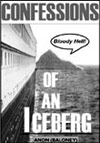 |
Molony, Senan (as Anon. Baloney) . Confessions of an Iceberg. The Icetory of the Hisberg Attacked by the Titanic. 1st printing. Dublin: Cedric Information Services. 2003. wraps. booklet. fiction. isbn: none. scarcity: hard to find.
For decades we humans have slanted the record by telling the tale from our own perspective alone. Finally, the iceberg gets to tell the story from his point of view. How skewed is the record? Well, for one, what is one of the most basic accepted facts. Why that it was the iceberg that struck the Titanic causing her mortal injury. But think about it. Who was racing 22 1/2 knots through the dark night, and who was floating serenely along at barely half a knot? It was the Titanic that struck the berg, not the other way around! Humorous fiction as only Molony can tell it.
|
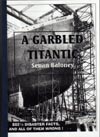 |
Molony, Senan (as Senan Baloney). A Garbled Titantic. limited, signed, 1st printing. Dublin: Glarbed Press. 2001. wraps. limited to 100 copies, signed by the author. isbn: none. scarcity: very scarce.
Back in the 1950s an author with the improbable name of Robert Manson Myers wrote a parody on the history of English Literature called From Beowulf to Virginia Woolf. It remains to this day one of my favorite humorous works. The humor is very clever, while not being afraid of descending into pure silliness. The book is filled with witty word play and audacious puns.
A sample:
William Shakespeare was the greatest dramatist the world has yet to produce. In extreme youth he settled at Windsor with his eight merry wives, where he remained until 1611, when he removed to Stratford-on-Auburn, more commonly known as the Deserted Village. Shakespeare is famous today for his plays, most of which have, unfortunately, been dramatized. It is little known that Shakespeare never wrote Shakespeare’s plays. Actually they were written by another man of the same name.
What Myers did to English literature, a fellow named Senan Baloney does to the story of the Titanic. Baloney tries to hide behind the equally improbable pseudonym of Molony, but we are now all wise to this deception.
Baloney’s book, A Garbled Titantic, is wickedly funny. I am not prone to fits of guffaws, but there were times when I was reduced to tears I was laughing so hard. Amazingly, the more you know about the story of the Titanic, the more in-jokes you will uncover.
An excerpt from the British investigation:
The eminent judge of the Embarrassing Incidents Court, John Bigwig, Lord Merciless, was chosen as the right man (to lead the investigation). The British ..... had a key acoustical advantage over the Americans: You could not hear a word that was said in the Scottish Kilt Hall.
The first witness called was Titantic lookout Archie Jewell. Br 1. “Are you Archie Jewell?” “May I please ask Mr. Itsme?” (Legal argument).
Baloney parodies everything connected with the Titanic story from the creation of the three great ships through the aftermath, the American & British inquiries and the supposed discovery of the wreck (he has 10 points which prove that was a hoax); even the celebrated Mystery Ship.
There are terrible, terrible puns (the best kind), mangled names and revisionist history. Those who have been reading the initial installments on the Titanic Mail List have not gotten the full story. Not only have they never seen the final chapters, but neither have they had the opportunity to check out some of the cleverly altered photographs peppered through-out the text.
One of my favorites being the classic shot of the newsboy selling the latest news on a London street corner. On the cover of the paper is the banner headline ‘Titanic Sunk or Damaged, or Poss[ibly] Just Fine’.
The book itself is twelve by eight, and attractively bound with a stiff card, rear cover and an illustrated, acetate front cover. This initial edition is limited to just 100 copies, each signed by the author.
For more information on-line, go to: Molony's A Garbled Titantic website.
|
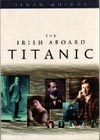 |
Molony, Senan. The Irish Aboard Titanic. 1st printing. Dublin: Wolfhound Press. 2000. wraps. isbn: 0863278051. scarcity: hard to find.
Many of the people who built the ship, and travelled on it as both passengers and crew were Irish. This book follows their experiences on that tragic voyage, told in their own words. Sources include interviews, letters, newspaper reports, family memories, White Star Line records and various other sources. It is the most comprehensive look at the part those of Irish descent played in the disaster.
For more information on-line, go to: the book's publisher's website, Wolfhound Press.
There was a larger, second printing in April of 2001.
|
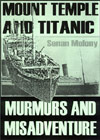 |
Molony, Senan. Mount Temple and Titanic: Murmurs and Misadventure. 1st printing. Dublin: by the author. December, 2003. wraps. booklet. isbn: none. scarcity: hard to find.
The Mount Temple was one of the ships on the Atlantic the night the Titanic sank. It's part in the events have always been shadowed in quiet controversy. It certainly was not the infamous mystery ship as it was on the wrong side of the ice field. But there are serious questions about whether Mount Temple's Captain Moore could have played a larger role in the rescue. Unfortunately, neither inquiry into the disaster questioned Moore very closely, despite statements by some passengers on Mount Temple that they thought they saw Titanic's distress rockets. All that remains are tantalizing clues and conflicting testimony. Molony once again puts his professional talents as a journalistic reporter to the case by taking a closer look at what may or may not have really happened on Mount Temple that night.
This research paper is available for sale on the Titanic Book Store page.
|
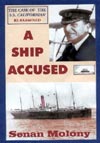 |
Winner of the Titanic Book of the Year Award for 2002.
Molony, Senan. A Ship Accused. The Case of the S.S. Californian: Re-Examined. 1st printing. Dublin: Cedric Information Services. January, 2002. wraps. isbn: none. scarcity: hard to find.
An author’s second, corrected edition came out in May, 2002. It is more precisely a second printing of the book with scattered typos corrected and some minor formatting problems fixed.
The night the Titanic was sinking, there seemed to be another ship just a few miles away from the doomed liner. A ship close enough to have saved everyone if only she had responded. But she never did. This vessel became known as the “mystery ship” and both the American and British inquiries independently determined that the identity of this ship was the Leyland liner S.S. Californian, commanded by Stanley Lord.
Whether or not the Californian was the notorious mystery ship has become one of the most fractious debates in the Titanic literature. Those who proclaimed that Californian was innocent became known as Lordites. Those who claimed the opposite, anti-Lordites. Then there were the rest of us, in the middle and just plain unsure, which made us the neutraLordites, I suppose.
The debate was addressed by three authors over the years, Peter Padfield, Leslie Harrison, and Leslie Reade. Padfield and Harrison were the Lordites, defending the innocence of the Californian. Reade was the anti-Lordite. He believed Californian was the mystery ship, and his book was the most persuasive of the three.
For many years I have bemoaned a critical rebuttal from the Lordite camp to Leslie Reade’s powerful indictment of the Californian’s role in the Titanic disaster. Peter Padfield’s book, way back in 1965 gave the basic arguments, but is long out of date. Leslie Harrison’s book is more recent, but his arguments fall far short of convincing.
With A Ship Accused, Molony takes up the challenge of Titanicdom’s most notorious brouhaha and delivers a knock out punch.
The proof was there all along in the testimony given at the American and British inquiries. The missing piece of the puzzle was that Titanic’s actual sinking position was not known until the late 1980s. Molony’s is the first book on the subject to take this critical new evidence into consideration.
Not only is Molony the first to detail the tremendous significance of the wreck site coordinates, but he is also the first to have taken the time to pore through the thousands of pages of evidence, pull out the relevant testimony, then collate that material into a cohesive whole.
In the course of some 50 chapters, he takes on one issue at a time, be it rockets, masthead lights, dead reckoning positions, you name it. He then brings together all the testimony about that issue, compares and contrasts the evidence, and sums up with his conclusion. The march of facts is enormous, at times it is downright numbing, but Molony’s dogged step by step approach never waivers.
The three authors before him tended to highlight the testimony that supported their position, and ignore anything that did not. Molony is the first to mention all the relevant testimony, for and against. He then attempts to explain the conflicting testimony. At times he has to go way out on a limb to get around certain issues, but he makes it plain where he is speculating and where he is sure of his facts.
The weight of his arguments is compelling.The author makes a strong case that the Californian was A Ship Wrongfully Accused.
|
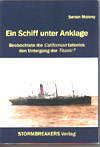 |
Molony, Senan. Ein Schiff unter Anklage. Beobachtete die Californian tatenlos den Untergang der Titanic?. 1st German edition. Elmshorn: Stormbreakers Verlag. April, 2002. hardcover. isbn: 3936160015. scarcity: hard to find.
A German language edition of A Ship Accused has been published. What's more, it is in hardback, a treat us English speaking bookoholics were denied! Susanne Störmer's publishing house has released the book for sale through her website, Stormbreakers. Here are the details for Ein Schiff unter Anklage on Susanne's Stormbreaker website.
|
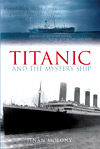 |
Molony, Senan. The Titanic and the Mystery Ship. revised & expanded edition. Gloucestershire: Tempus Publishing. May, 2006. wraps. isbn: 0752437437. scarcity: fairly common.
This book was first published privately by the author in 2002 with the title A Ship Accused. Tempus Publishing has just released a completely revised, reedited and somewhat expanded edition, with this new title. Like the original, this is a no holds barred critique of the “mystery ship” debate, with emphasis on exonerating the Californian as being the ringer.
Anyone who has read my review of A Ship Accused knows how highly I respected that work. If there was any flaw, it was that Molony’s style of writing could be somewhat rambling and disjointed at times. This updated version, masterfully reedited and revised, corrects this flaw by composing the author’s arguments into an even tighter point by point examination of his evidence. No real surprise as Molony is a professional journalist for Ireland’s largest selling daily newspaper. It is a pleasure to watch his writing talents mature.
The images in the original work were also somewhat less than could be desired, not a flaw, but the necessity of an individual publishing his own work, and the resulting tradeoff of quality versus budget. This new edition, with the resources of a publisher behind it, corrects this issue as well. There are 32 plates produced with excellent clarity, as well as quality detailed illustrations within the text.
One complaint already mentioned elsewhere, is that the point size of the text is quite small, and this is a true statement. Us “elderly challenged” folks need cheater glasses to read this book with any ease. But again, this cannot be considered a flaw as the volume of text is just extraordinary. Considering the high cost of paper today, reducing the size of the type was the only way to bring the entire book to within a page limit that could afford to be published.
Molony takes the reader on a step by logical step guided tour of the evidence, explaining each detail in clear and concise language purposefully adopted for the casual reader. He is not afraid to take on opposing theories, giving evidence taken primarily from the original inquiries, the words of the men and women who were there, to show equally reasonable alternate explanations.
So has the ultimate mystery ship book been written? Depends on which side of this debate you fall on. Those who believe Californian was the mystery ship will remain unconvinced. Those who think otherwise will consider it to be a slam dunk, case closed. Without taking sides, all I intend to say is that this is the most comprehensive, detailed account of the mystery ship debate that has even been printed. It simply blows every previous book out of the water. That’s not to say that an equally powerful book for the opposing point of view couldn’t be written; but it hasn’t been - yet.
In any event, whether pro or con, if you are interested in this convoluted subject, Titanic and the Mystery Ship is a must have book for your collection.
|
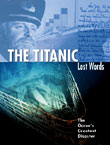 |
Molony, Senan. The Titanic, Lost Words. 1st printing. Tunbridge Wells, Kent ticktock Media. September, 2005. wraps. children’s book (Ages 8 to 12). A volume in the Lost Words series. isbn: 1860078346. scarcity: hard to find.
This nonfiction book for children explores the disaster through the words of those who were involved, along with historical commentary by Titanic historian Molony (whose name is misspelled in the first UK printing as Malony).
This is a beautifully illustrated work with images on most pages in color and black & white. The text covers the entire story in quick, but thorough detail, augmented by original accounts with quotes, letters and speeches from survivors, and newspaper articles. The style of the writing is journalistic with a refreshing just the facts approach. Content is excellent.
In its brief 48 pages the work covers all the basics of the story from an introduction to the White Star Line right up to current events, like the discovery of the identity of the “unknown child”. Other chapters cover the construction, the voyage, the disaster and aftermath. There is also a chapter on Titanic in media, biographies of some of the major figures in the story, a glossary and an index.
The author is a well known defender of Captain Lord of the Californian, and, though it is not a major part of the book, he continues with this defense. Those who disagree with him will be annoyed at his one sided, Lord was innocent, approach. But this is really a minor issue for all but the most rabid of those with contrary opinions of the infamous Californian issue.
There are by now hundreds of books for young readers on this subject. Molony’s book is one of the better ones in the nonfiction category, one of a mere handful that I can heartily recommend without reservation.
|
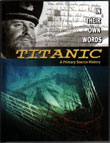 |
Molony, Senan. The Titanic: A Primary Source History: In Their Own Words. 1st American printing. Milwaukee: Gareth Stevens Publishing. September, 2005. hardcover. children’s book (Ages 8 to 12). isbn: 0836859804. scarcity: hard to find.
The American edition of the previous listing with a slightly different title. This version is also in hardcover whereas the British edition is in paperback. Otherwise the content appears identical.
Notice that Amazon.com is incorrectly listing this edition as softcover, which it is not.
|
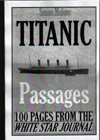 |
Molony, Senan. Titanic Passages. Editor’s Selection of 100 Pages from the White Star Journal. 1st printing, SIGNED by the author. Dublin: Cedric Information Services. January, 2003. wraps. isbn: none. scarcity: hard to find.
For the past several years, Molony has been the editor for the Irish Titanic Historical Society’s quarterly magazine, the White Star Journal. Titanic Passages contains a selection of articles he has written for the journal during his stewardship as editor. There are about 65 articles all together on a whole spectrum of topics as diverse as a piece about Captain Rostron’s celebrated sighting of a sea serpent to the discovery of a photograph believed to be the very last one ever taken of Titanic.
|
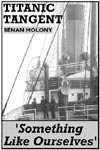 |
Molony, Senan. Titanic Tangent: Something Like Ourselves. 1st printing. Dublin: Cedric Information Services. September, 2002. wraps booklet. fiction. isbn: none. scarcity: hard to find.
Molony’s latest is a novella set aboard the Californian describing events on the night of April 14th, 1912. What actually happened on the Californian that night? What did the crew see? How well did they comprehend what they were seeing? Why did they respond the way they did? Unlike the modern reader, the crew had no access to the rest of the story to aid them in understanding what was happening. This approach makes for an interesting exercise in perspective that, to my knowledge, has not been attempted before. It makes for a thought provoking new angle on how we might want to interpret the Californian’s role.
From the posts on various message boards, it is obvious that a lot of people have given considerable thought to what the deck officers on the Californian could have done , or should have done, the night Titanic was sinking. Most of that reaction is based on 20/20 hindsight. But have you ever tried to step back in time and put yourself in the shoes of the crew of the Californian and look at the experience from their point of view, while the actual events were occurring?
In this short fictional recreation, Molony attempts to do just that. Play out one possible sequence of events as they might have occurred. Although it is a work of fiction, the author based the crew’s conversations and actions on the testimony they gave at the inquiries, so the story is grounded in fact (or perhaps more accurately, it is grounded in the facts as represented by the men of the Californian). Where there are gaps in the testimony, the author fills in with his own imaginative speculation so that a coherent story line can be maintained.
The narrative is told through the viewpoints of four men over the course of the night. The ship’s captain, Stanley Lord begins the narrative at 10:15 p.m. Herbert Stone, the 1st mate, takes up the story at 12:10 in the morning when he comes on duty. The apprentice, James Gibson continues the account through the early morning hours of April 15th. George Stewart, the Californian’s Chief Officer, wraps up the night when he comes on duty at four in the morning and begins to wake the ship up for the day.
As with any account regarding the Californian, the writer’s stance on the issue is important to understanding their intentions. Molony is a well known, vocal supporter of Captain Lord. Not only does he believe the crew of the Californian were innocent of the charge that they failed to come to Titanic’s aid, he ardently believes that Lord was completely blameless. It should come as a surprise to no-one, then, that this novella treats Lord in a favorable light. Some readers will agree completely with that interpretation and others will likely have a strong negative reaction, depending on their own personal views on the subject.
This book succeeds because it allows you to observe that night without, as much as is possible, all the historical perspective to color your viewpoint.
|
|
Molony, Senan. Titanic: Theatre of Fate. This was the working title for what ended up being called simply Titanic for the Lost Words Series. See above.
|
Other Shipwreck Books by this Author.
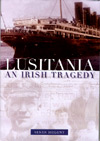 |
Molony, Senan. Lusitania: An Irish Tragedy. 1st printing. Dublin: Mercier Press. October, 2004. hardcover. isbn: 1856354520. scarcity: hard to find.
Molony's book about the Lusitania disaster focuses on the sinking with emphasis on the impact the tragedy had on Queenstown, where the survivors were landed, and where the bodies of the victims were recovered. Since that time Queenstown has been renamed Cobh.
What will be of interest to Titanic readers is that Molony approaches Cobh as the "Halifax" of the Lusitania tragedy. Any Titanophile will know what that means. Since Cobh was the last port of call of the Titanic, there will be much of interest to Titanic enthusiasts in the many spectacular photographs of the port uncovered from 1915. There are references and new facts about the Titanic scattered throughout the text.
The book has no fewer than 185 illustrations - 160 of them completely new and unpublished, the best being from a batch of glass plate negatives of the tragedy's immediate aftermath which have never seen the light of day. Although the Titanic content is certainly secondary to the main subject of the book, there seems to be enough content to interest readers in either, or both, of these infamous disasters.
|
|
|
|
|